Top 7 Technologies Powering Product Development Services

In the current world of sparkling world user expectations and fast-paced market shifts, businesses have to rethink the joy of designing, building, and delivering value. At the heart of this transformation are product development services, an all-encompassing set of services that assist businesses in going from concept to launch using state-of-the-art digital enablement.
The Innovative product development process is, thus, in contradiction with the legacy model: agile, collaborative, and data-driven at its core. It is a confluence of cutting-edge technological tools, feedback loops, and cloud-native infrastructure to develop scalable solutions for the end-user.
Today, products are intelligent and adaptable and have future-ready features; this calls for an entirely different mode of thinking in product development strategy.
This blog intends to discuss seven technologies that are among the most impactful changes to product development services in the digital era today. From AI technology to cloud-native platforms to simulation and collaboration tools, learn how the right tech stack is creating waves in the industry.
Table of Contents
Technology-Powered Product Development in 2025
| Aspect | Explanation |
| Why Companies Use These Services | To stay ahead of the competition, businesses are embracing services supported by AI, automation, digital twin technology, and immersive tools like AR/VR. |
| Key Technologies | – AI: Improves predictions, insights, and smarter decisions – Automation: Reduces manual work and speeds up processes – Digital Twin: Simulates real-world scenarios for better testing – AR/VR: Enhances product visualization and user experience |
| Main Benefits | – Faster innovation cycles – Better alignment with business goals – More efficient and flexible development processes |
| Role of Tools and Software | Help reduce manual tasks, improve accuracy, and support better decision-making throughout the product lifecycle. |
| Stages Empowered by Tech | Every step, ideation, prototyping, testing, and launch is now enhanced by smart tools that make the process more efficient and reliable. |
What is Cloud-Native Platforms?
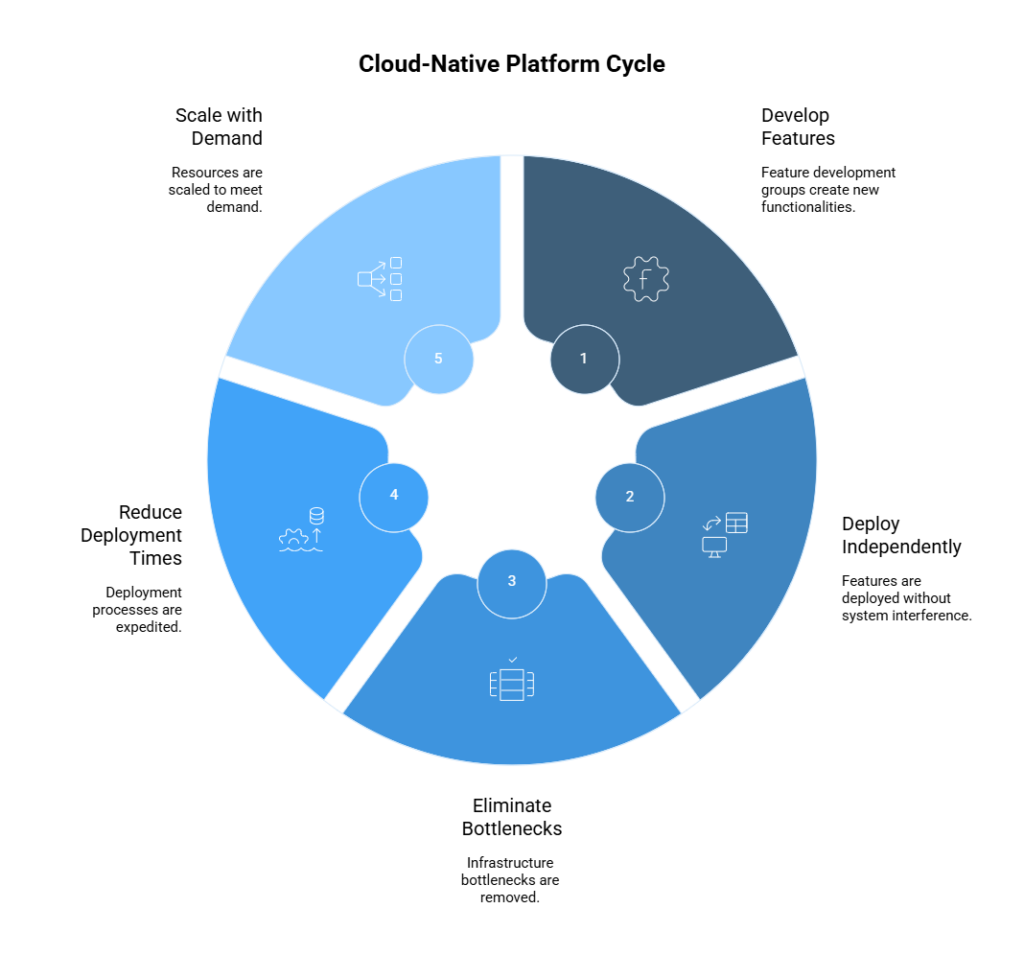
Cloud-native platforms are modern application environments explicitly created to harness the many benefits of the cloud. Building on microservices, containers, serverless functions, and APIs, they help an application fold in more agility and easier scale-out.
Unlike traditional on-premises infrastructure, a cloud-native platform allows all feature development groups to deploy their features independently, without any interference with the entire system. Such modularity fits well with the present-day product development process that appreciates speed, agility, and response to market feedback.
Within the arena of product development services, cloud-native platforms eradicate infrastructure bottlenecks, bring down deployment times, and provide scaling timewise with demand growth.
Start Your Product Development Journey
Benefits of Cloud-Native Architecture in Product Development
Building and delivering products on a cloud-native architecture provides businesses with flexibility, scalability, and resilience. Hence, these qualities, along with modern product development services, fit hand-in-glove since speed, innovation, and reliability are prime concerns nowadays.
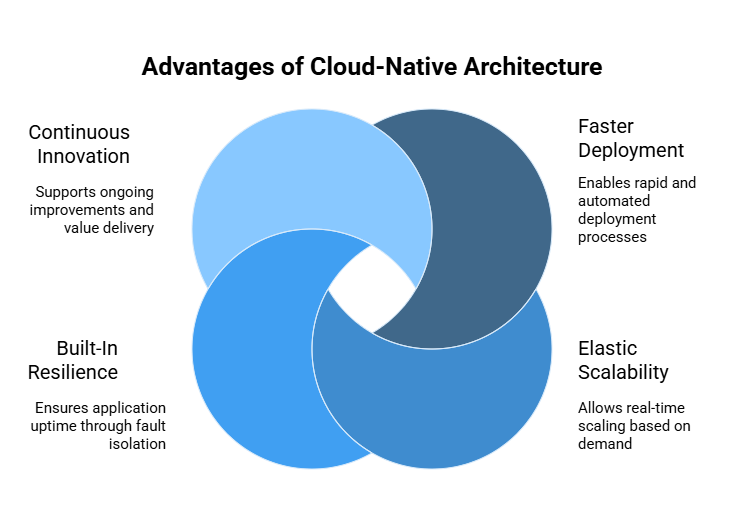
Faster Deployment through CI/CD and Containerization
With the help of continuous integration/continuous deployment (CI/CD) pipelines, developers can test them in an automated way and deploy the latest builds to the live production environment even faster. Docker and Kubernetes serve as tools for containerizing the application for teams and deploying microservices independently: this means faster rollouts for features and shorter time-to-market, which today is most important for companies that invest in development services.
Elastic Scalability Based on Demand
Cloud-native environments also enable the auto-scaling of apps on demand in real-time. If a sudden burst of traffic emerges due to a marketing campaign, launch, or product promotion, these applications manage to grow or shrink autonomously without increasing any manual intervention. Such elasticity offers help in cost management for keeping organizations involved in product development services as well as ensuring uninterrupted performance.
Built-In Resilience and Recovery
Lit Systems have excellent resilience measures that allow fault isolation, redundancy, and automatic recovery so that even if one service fails, the application remains up. Such resilience is a must wherever product development companies prioritize uptime and user satisfaction.
Continuous Innovation at Speed
By allowing more minor, incremental changes to be constantly tested, learned from, and improved upon, the cloud-native architecture perfectly suits the product innovation mindset, in which fast and continuous delivery of value is the key to success in the long term.
The Evolution of Product Development: From Waterfall to Agile + Tech
In short, product development has seen a complete overhaul, changing from inflexible, linear models to complex, technology-driven frameworks. This evolution has provided a complete change in the traditional approach businesses follow in order to deliver their value, and modern product development processes are being placed at the helm of this change.
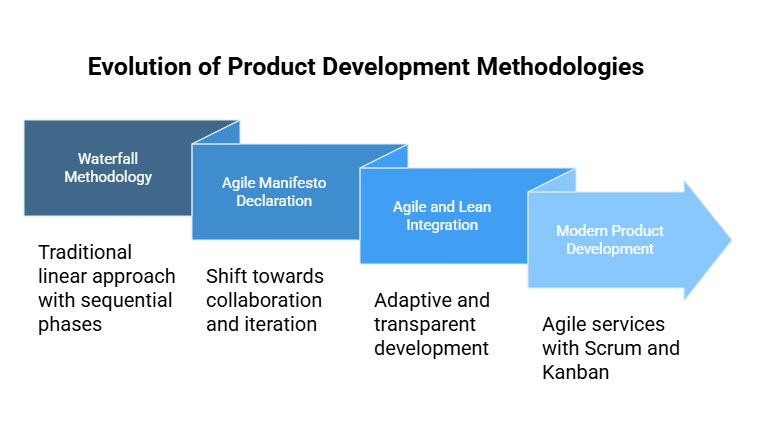
Waterfall: The Heritage Style of Making a Product
For many years, product development was conducted mainly through the waterfall approach. The stages of this methodology were linear: requirements, design, development, testing, deployment, and maintenance. One phase had to be complete before the next would begin.
For very structured and predictable projects, it would have worked. The waterfall model lacks flexibility. Any late change in requirements or customer expectations would have meant rework, time wasted, and exorbitant costs. Feedback loops used to be far apart, and verification of product-market fit mainly happened after the product was released.
Rapid development in what end users want and in technology serves as a curse for such an old system. This traditional framework thus lags way too much for any modern digital product and is miles away from the user’s reality. Hence, the reasons modern companies favor product development services are that they promote agility and tech-mindedness.
Agile and Lean: A Quick Response to Change
The year 2001 witnessed a turning point when the Agile Manifesto was declared. Agile methods suggest collaboration, rapid iteration, customer feedback, and continuous delivery, and these very principles now comprise the core of product development.
Agile brought in the idea of moving from working on fixed requirements to satisfying customer value incrementally. Lean thought brought about the elimination of waste, the optimization of flow, and the ability to do only what is needed. Together, modern product development is developed to be very adaptive, transparent, and result oriented.
Most product development companies today provide essentially agile services themselves. Whether it is through the use of Scrum, Kanban, or some hybrid approach, these services enable cross-functional teams to collaborate closely, quickly respond to change, and continually deliver working software.
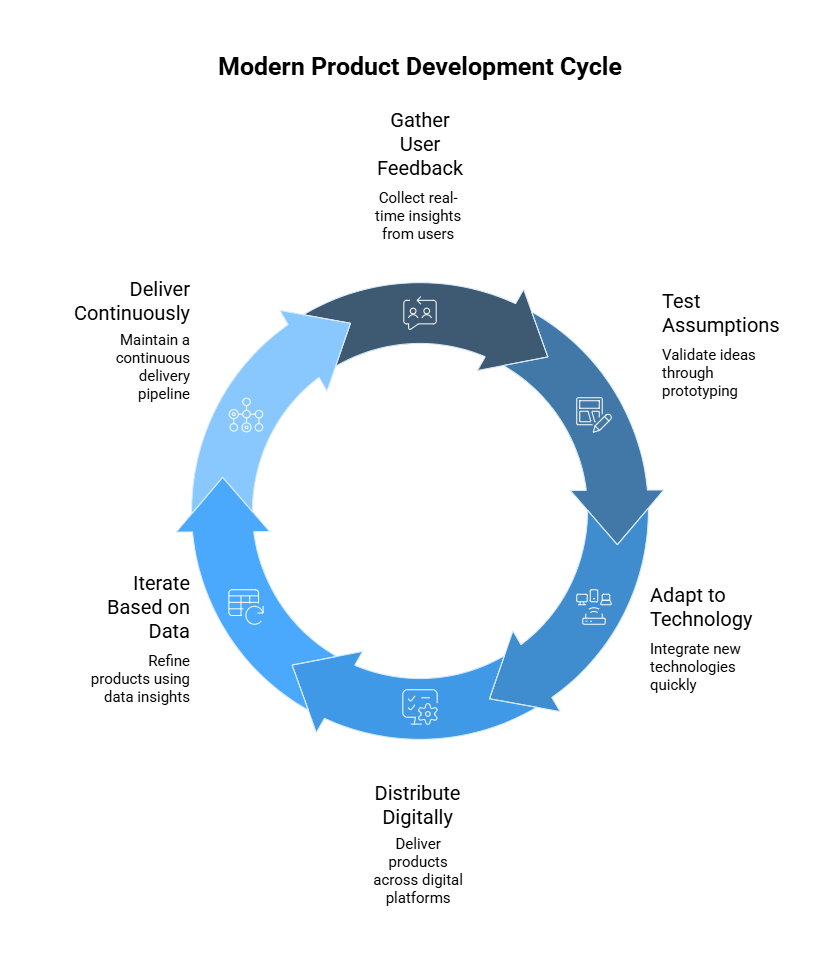
Why Traditional R&D No Longer Works
In the matter of legacy R&D models they were created for an industry where cycles of innovation were just slow and hence predictable relatively. But in this digital age, customers demand products that are personalized, intuitive, and evolving, and they want it now.
Traditional models flounder at:
- Gather real-time user feedback
- Test assumptions early through prototyping
- Adapt to ways of fast-changing technology
- Distribute across digital channels and platforms
In contradistinction, product development services choreograph agile workflows and digital tools to prototype, iterate according to data, and bring products to market faster. Building for 12–18 months is simply not an option for companies anymore. These must be validated faster with smarter decisions and continuous delivery pipelines.
Digital Transformation: The Technology Shift
Digital transformation has immensely accelerated the shift from old-school methods of product development to tech-empowered ones. Cloud computing, AI, low-code platforms, and DevOps have changed the meaning of being possible and how fast something can be done.
According to the above points, It now allows:
- Real-time collaboration across worldwide teams
- AI-based user insights and automated testing
- Cloud-native infrastructure scaling on demand
- CI/CD pipelines
The transformation is not just about tools; it is a mindset transformation. Businesses embracing digital transformation in developing their product development strategy are more resilient, innovative, and customer-need-oriented.
The Role of DevOps in Modern Product Development
Offering software faster, more reliable, and at scale is one of the significant competitive advantages for companies. DevOps- the set of practices that integrate software development and IT operations- became an inevitable factor in achieving this goal. Fundamentally, DevOps cultivates a culture of collaboration, sharing of responsibilities, and continual improvement. Embedded in modern product development, DevOps allows for rapid delivery, enhanced stability, and strengthened resilience of systems. Hence, it is considered among the rocks upon which effective services stand.
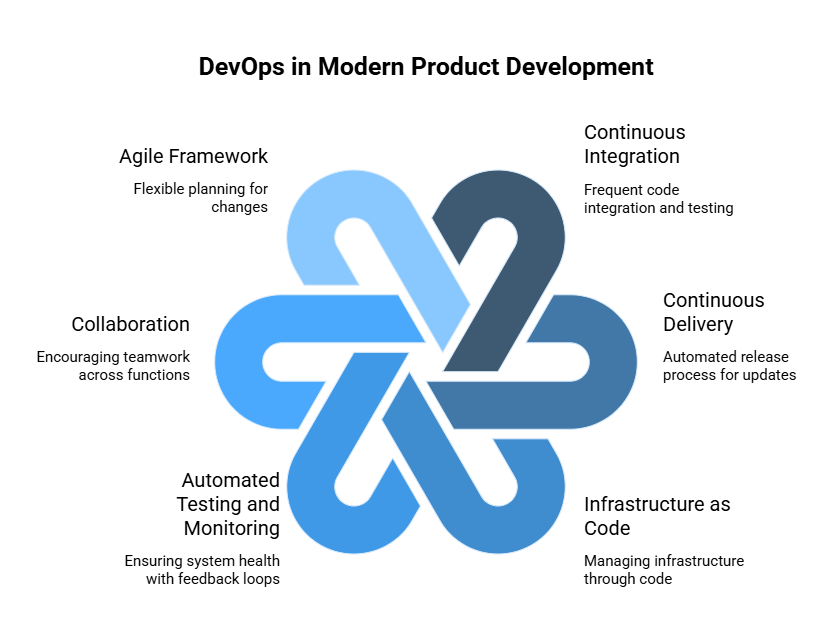
Unifying Development and Operations
Traditionally, development and operations worked in silos, with developers writing code while operations teams focused on deployment and infrastructure. This situation created delays and miscommunications, with releases that were sometimes unstable. DevOps closes that gap by encouraging collaboration across all functions from conception through product life. This approach essentially removes bottlenecks in the system, placing equal consideration on both code quality and infrastructure readiness from the beginning of product development, a big plus in the modern product development services arena.
Key DevOps Practices in Product Development
Several key aspects of operations encompass DevOps and provide for agile, quality delivery of the product:
- Continuous Integration (CI): In such workflows, developers integrate code into a shared repository frequently; in turn, automated builds and tests are run against the integration builds. Such processes catch bugs at an early stage and help with code stability.
- Continuous Delivery (CD): Builds the concept of CI by automating the release process so updates can be deployed with minimal manual intervention into the production environment. This allows for frequent low-risk deployments, which is fundamental to agile product development services.
- Infrastructure as Code (IaC): Administration of infrastructure via code-provision to environments in an automatic and consistent manner-services for better scaling and resolution of “it works on my machine” issues, a common hindrance faced by distributed product teams.
- Automated Testing And Monitoring: These consist of automated unit, integration, and regression testing, as well as real-time monitoring of application performance. They ensure system health with feedback loops that are short and speedy recovery from issues.
Not only do these methods tremendously reduce development times, but they also improve reliability and decrease operational risk. The teams delivering development services need to strike a balance between speed and quality.
Enhancing the Product Development Roadmap
Until recently, DevOps was considered a stage after the product roadmap. However, one of the essential goals of a DevOps culture is to have smooth transitions from concept to deployment. Teams can push out updates on a more incremental basis and receive constant user feedback. This agile framework will also align itself with DevOps, allowing flexible planning for changes in functionalities as per user requirements.
Thus, that iterative feedback loop becomes a core factor in the latest product development services. At the same time, a high frequency of releases, faster discontinuances from bugs, and ongoing improvements in the active presence of DevOps turn the product development cycle from a linear to a dynamic and responsive one.
A Competitive Advantage in a Fast-Moving Market
In this way, DevOps is not just about improving internal processes but delivering business value. Organizations that implement DevOps practices attest that their delivery times become faster, the satisfaction of their customers increases, and the software is much more stable. Hence, this results in bringing to life high-quality products ready for the market with the shortest time-to-market possible.
To reiterate, DevOps is therefore at the heart of enabling modern, scalable product development services and high performance. It allows teams to innovate continuously, react to the marketplace quickly, and develop highly reliable products focused on the user.
Let’s Build Your Product from Start to Success
Top 7 Technologies Powering Modern Product Development Services
In the quick-paced digital days of today, companies are realizing greater pressure to innovate and produce.
For the sake of the game, every company is strategically deploying new-age technologies to assist in fast-tracking the processes from time-to-market and ensuring product quality. These innovations are considered with which companies build smarter, scalable, and user-centric products.
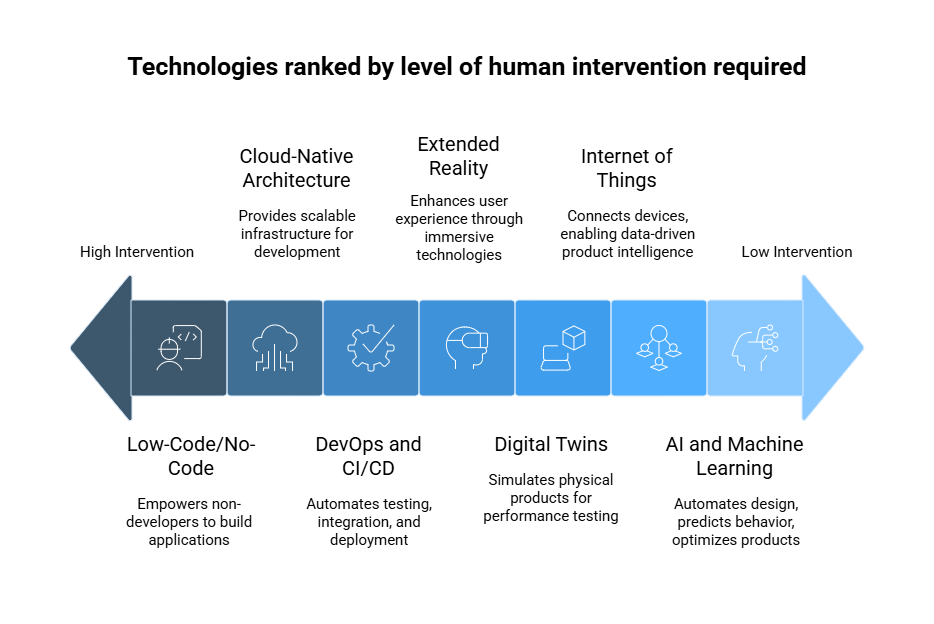
Artificial Intelligence (AI) and Machine Learning (ML)
AI and ML are transforming how companies conceptualize, design, and optimize products. These technologies provide product design and development services that support data-driven decision-making, predictive analysis, and intelligent automation.
With AI in product development, teams simulate product performance, predict customer behavior, and even carry out designs or testing on a routine basis. Meanwhile, ML algorithms keep learning through multiple data inputs, thereby assisting product developers to tweak their products faster and more accurately to market demands.
For instance, in e-commerce product design, an AI-powered recommendation engine could suggest new features based on how customers are using an existing product. In more manufacturing-related product development services, AI predicts maintenance requirements or optimizes supply chains.
Because AI performs repetitive human work, it improves precision, thereby enabling the team to innovate at a much higher-order level and stands out as one of the biggest enablers of full-cycle product development today.
Cloud-Native Architecture
Cloud computing is the backbone of agile product development services. With cloud-based infrastructure, development teams gain product testing, build, and deploy much faster, leveraging scalable platforms and shared resources.
AWS, Microsoft Azure, and Google Cloud provide services by which organizations can host microservices, run their CI/CD pipelines, and do infrastructure-as-code with minimal downtime; this flexibility ensures that developers, collaborating from different parts of the world, can see real-time updates and manage applications from anywhere.
Further, cloud-native platforms keep abreast with containerization (via Docker/Kubernetes), which assists application developers in decomposing huge complex applications into smaller parts. This enhances fault tolerance and lessens deployment friction, thus expediting the release process.
To surf the latest in product development services, cloud technology continues to act as a force, majorly sustaining the semantics of seamless scalability and faster time to market.
DevOps and CI/CD Pipelines
DevOps aids in the integration of development and operations teams with a view to releasing software faster, more efficiently, and also more reliably. This method constitutes an imperative process for product engineering services in the modern world, especially in terrains of continuous innovation and rapid iteration.
In this way, using CI/CD pipelines, dev teams are given the opportunity to put their automation scripts on testing, integration, and deployment processes. Hence, any change in code becomes immediately tested and pushed into production strictly without manual intervention.
Primary DevOps tools include Jenkins, GitLab CI, Azure DevOps, CircleCI, and many more: they help developers discover bugs early on, maintain code quality, and deploy more frequently.
With DevOps, the culture of collaboration, responsibility, and automation is placed front and center, thus enabling faster and better-quality product development services and making it an indispensable methodology for any truly agile organization.
Internet of Things (IoT)
The Internet of Things is set to have a significant influence on industries that use connected devices, such as the automotive industry, healthcare, agriculture, and manufacturing. In these industries, product development services must deal with real-time data exchange, device interoperability, and embedded systems.
IoT supports communication among physical devices themselves or within a centralized system. This very much allows developers to create more innovative products that derive their intelligence from data and can react to the environment or behavior of the user during product development.
Wearables for fitness collect health data and transfer it to mobile apps, which then analyze patterns and suggest health improvements. Industrial equipment in an IoT environment may alert technicians to a degradation in its performance so that they might intervene before a failure occurs.
Nowadays, product development service providers need to be fluent in IoT so that the products are secure, scalable, and responsive in IoT-connected ecosystems.
Digital Twins
A digital twin is a virtual representation of a physical product, system, or process. The virtual environment simulates the actual conditions, allowing teams to assess performance, troubleshoot problems, or predict behavior in the absence of prototypes. This phenomenon is proving critical in product development services, particularly in aerospace, automotive, and manufacturing industries where product reliability is paramount.
Engineers evaluate their designs with simulations of stress conditions, temperature ranges, or usage patterns via the digital twin before manufacturing the actual product. In this way, the cost of manufacturing is reduced, faster time-to-market is ensured, and safety is improved.
Also, in conjunction with IoT data, digital twins are able to infer real-time feedback between product usage and development, thereby creating more connections that collectively improve customer experience and product transformation. This significantly proves the strategic value of the digital twin in product development services.
Low-Code/No-Code Platforms
Creative product development is made possible for ordinary people through low-code/no-code application environments; a business analyst or designer may build apps and workflows. Platforms such as OutSystems, Mendix, Microsoft Power Apps, and Bubble actually enrich the universe of custom product development services with speed and inclusiveness.
These are designed for reduction in coding by traditional means, allowing the team to prototype ideas and validate them quickly. They are perfect solutions for internal tools, MVPs (Minimum Viable Products), and business process automation.
Low-code solutions are great for bridging communication between the business stakeholders and the developers, thus short-circuiting feedback. Therefore, the evolution of the product becomes faster.
For product development, these platforms provide a very cost-effective yet rapid way of innovation whilst relieving engineers to address the more complex tasks.
Extended Reality (AR/VR/MR)
Extended Reality enhances the user experience with products, especially in sectors such as retail, real estate, healthcare, and education. The different kinds of Extended Reality systems are Augmented Reality, Virtual Reality, and Mixed Reality.
From immersive design reviews to interactive prototyping, virtual testing, and even presentations to customers, XR is used by product development companies.
For example, teams can walk through a digital model of a car before it is built in automotive design, while AR applications in retail let buyers see how their furniture will look in their homes.
Increasingly so, XR is becoming involved in training, remote assistance, and product maintenance. In terms of accessibility, this product development technology will soon approach cheaper, facilitating fresh modes of thinking, designing, and engaging users in the domain of product development services.
How to Choose the Right Technology Stack for Product Development
Choosing the right product development technology ranks among one of the most critical decisions every product journey ever must make. This, in turn, spells an impact on the speed of development, performance, scalability, and costs, being the key factors that contribute to the outright success or failure of your product development strategy. For any company working with product development services, making informed tech decisions at the very start would make future success.
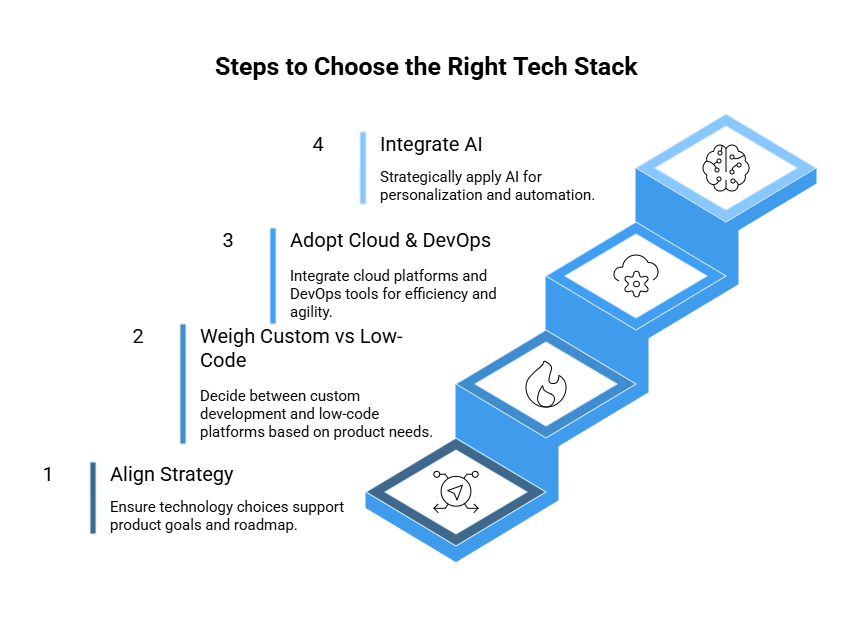
Align Technology Choices with Product Strategy and Roadmap
Technology decisions should always follow strategy, not lead it. Before you choose your tools or platforms, you should examine the product’s development roadmap. What are you building? Who is it for? What market does it go to? What does the MVP look like, and how is it developed?
For example, B2B SaaS platforms are in some way a totally different big castle from consumer mobile apps. While one may be concerned with secure API integrations and database scalability, an entirely different kind of thing could be over offline features and slick UX. These decisions will define the choice between monolithic and microservices architecture, front-end framework, cloud provider, and programming language.
Such alignment sets the stage for well-structured product development services. They consider goals, growth projections, and user behavior to recommend a stack that not only fits today but supports what lies ahead for the product in the next phase.
Weighing Custom Development vs. Low-Code Platforms
Not every product needs complete custom coding from the ground up. In the past, low-code and no-code platforms experienced significant growth and, nowadays, allow high-speed development with so much flexibility.
Low-code platforms like OutSystems, Microsoft Power Platform, or Mendix can be leveraged for faster delivery of internal tools, workflows, and admin dashboards. Hence, they are wonderful for proof-of-concepts, MVPs, or small apps that must be fast-tracked with little to no investment.
Yet, for more specialized digital products such as fintech platforms, AI-driven applications, or anything that deals with backend control to some serious degree, custom design must be retained. This provides a far greater degree of flexibility than low-code approaches can offer, plus it allows for security and performance.
An increasing number of product development services nowadays adopt a blended methodology: low-code solutions for non-core functionality and pure custom code for the unique customer-facing functionality of the product. This hybrid method is fast-paced and never compromises any critical business logic.
Adopting Cloud, DevOps, and AI Smartly
Above and beyond languages and frameworks, contemporary product development constitutes the operational layers of infrastructure and intelligence, specifically cloud platforms, DevOps automation, and AI integration.
- The cloud has become a necessity; deployment, realization of scale, and infrastructure costs have become matters of efficiency, whether Azure-based, AWS-based, or GCP-based. Hence, cloud platforms highly favor product-developing services operating in dynamic and rapidly growing environments.
- The DevOps tools in Jenkins, GitHub Actions, Azure DevOps, and Terraform are geared toward automating the testing, deployment, and monitoring of applications. It supports good agility wherein more minor releases occur more frequently, and problems are resolved in a short time.
- If applied strategically, AI can profoundly improve the product. Some of the capabilities offered by AI integration in product development are personalization, predictive analytics, fraud detection, intelligent automation, and so on. Azure Cognitive Services is one of the several tools available to embed intelligence without the need for a whole data science team.
Common Challenges in Tech-Driven Product Development (and How to Overcome Them)
There is an hourglass setup between faster product development and increasing complexity in the newest-generation tools and platforms. From integration challenges to security concerns, a gamut of issues can act as bottlenecks in the path of product development. On the other hand, such problems can be well addressed by appropriate actions and the assistance of proficient product development services.
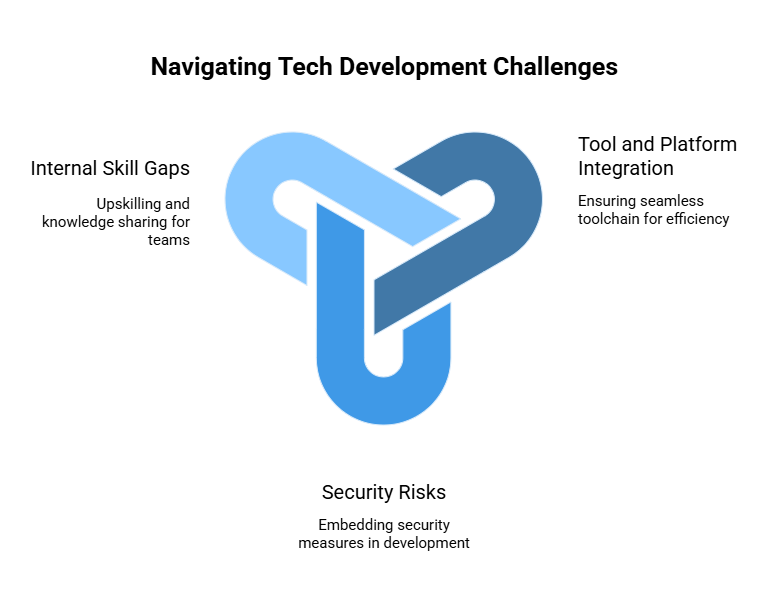
Tool and Platform Integration
Management teams in software development can be reliant on so many tools, such as a design system, one CI/CD platform, an analytics dashboard, and a project management app. When poorly integrated, these foster siloed data, duplication of work, and communication issues. Selecting interoperable tools and automating workflows should thus be the solution. An experienced product development services agency will create a seamless toolchain-once-in-a-lifetime that blocks friction in the development process and aids team coordination.
Security Risks in Cloud-Native and IoT Environments
Cloud-native architectures and connected devices offer a particular kind of flexibility while increasing attack surfaces. Misconfiguration of an API, unsecured database, or even unpatched firmware can invite threats to the system. Security should be embedded in every phase of product development processes. DevSecOps, encryption, and automated security scanning are some of those that modern product development services have now incorporated.
Internal Skill Gaps and Change Resistance
Technology has often moved faster than the capacities of internal teams. Teams might struggle with Agile methodologies, cloud migration, or AI integration. All this has created bottlenecks that affect delivery quality. Given this scenario, the entire focus on upskilling and knowledge sharing within a company is paramount. Product development services provide embedded support, mentoring, and change management frameworks through which teams can be assisted with a smooth transition.
Future Trends in Product Development Services
On account of advancing technology, product design services are turning into a little more intelligent, automated, and distributed. Innovations working on accelerated delivery, tailoring user experiences, and streamlining operations across the product lifecycle will rule the future.
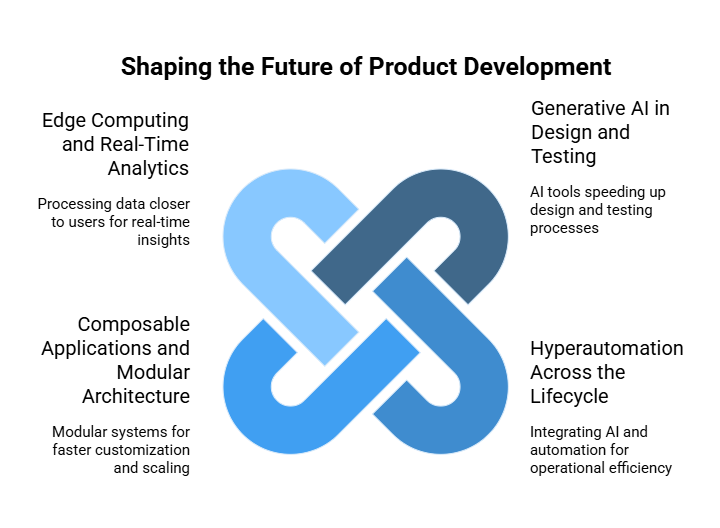
Generative AI in Design and Testing
Generative AI is changing the way teams design, prototype, and test products. Large language model-based tools can create UI mockups, generate code snippets, simulate user interactions, and write automated test cases. In effect, this speeds up early workflows tremendously. In the future, more responsibility will be passed on to AI in the realm of future-oriented product development services to provide less tedious work and faster cycle time for iteration.
Hyperautomation Across the Lifecycle
Hyperautomation, integrating AI, machine learning, RPA (robotic processing automation), and low-code tools, will reshape operational effectiveness. From automatic backlog grooming to intelligent test orchestration and release management, product teams can eliminate manual handoffs. As hyper-automation grows, from product development service to self-operating pipeline, it keeps new incumbents for devs for strategic innovation.
Composable Applications and Modular Architecture
Getting momentum has perhaps shifted from monolithic systems to composable applications. The modular nature guarantees faster customization, easier maintenance, and scaling upgrades. Future products will be Cartesian composites of interchangeable components, micro frontends, APIs, and packaged business capabilities. Hence, product development services embrace this approach to make digital ecosystems future-proof.
Edge Computing and Real-Time Analytics
Edge computing today is essential for the exponential growth of connected devices and decentralized systems. It allows data to be processed closer to the user, thereby reducing latency while supporting near-real-time insight generation. When combined with AI, this method can enhance production environments such as healthcare, retail, and logistics to manufacture more innovative products.
Final Thoughts
An ecosystem of powerful technologies has rapidly evolved into the product development service landscape to optimize all phases of the development lifecycle. From ideation and prototyping to testing and deployment, companies have so many tools aimed at making innovation quicker, smarter, and more user oriented.
This is the perfect time to embrace these seven technologies if one wants to dramatically enhance one’s engineering capabilities to deliver high-impact products that truly meet today’s fast-moving market needs, whether for software, hardware, or hybrid solutions.
With increasing customer expectations growing tougher in competition, the one-time choice to go for future-ready product-development services is now a must-have. To reduce costs and achieve faster turnarounds, businesses are leveraging tools such as AI, DevOps, and digital twins to stay ahead of the curve.
In a world where swelling changes are the only constant, technology lends agility to such. And for those companies that speak of scalable success, it is the means for modern times product development services, with its groundbreaking technologies.
If you are looking for product developnent services, you can visit here.
Frequently Asked Questions
FAQ 1: What are product development services?
Product development services refer to a comprehensive set of offerings that help businesses take an idea from concept to market-ready product. These services typically include product strategy, design, prototyping, software development, testing, deployment, and ongoing support. Modern outsourced product development is tech-driven and agile, combining user-centric design with scalable engineering to deliver high-impact digital solutions.
FAQ 2: Who should consider using product development services?
Product development services can be helpful for startups, SMEs, and large enterprises alike. They tend to be more attractive to companies with little or no in-house development capabilities, who require specialized expertise, or who want to expedite product-launching operations. Developing an MVP or a digital product or modernizing legacy systems–these services help to reduce risk through streamlined process management.
FAQ 3: What technologies do product development services typically use?
Product development services utilize a plethora of technologies depending on what the project at hand demands. These technologies may involve cloud platforms like AWS or Azure, programming languages like JavaScript, Python, or .NET, mobile engineering frameworks such as Flutter or React Native, or Windows-based DevOps tools and AI/ML platforms. The tech stack always aligns with your product goals, scalability requirements, and roadmap for the future.
FAQ 4: How do product development services support innovation and speed?
This service speeds development cycles while maintaining quality by adopting Agile methodologies, integrating them into automation tools, and providing other GiPro product development tools for fast development. Teams work in Agile iterations, continuously run tests, and implement feedback on the fly, thereby enabling a business to innovate faster, shorten time-to-market, and more effectively respond to user demands and competitive pressures.
FAQ 5: How do I choose the right partner for product development services?
Look for a partner with proven experience across industries, a strong portfolio, and expertise in modern product development technologies. Evaluate their process of transparency, communication approach, and ability to scale. A good product development service provider will align with your business goals, offer strategic input, and take ownership of delivering a successful product, not just writing code.



